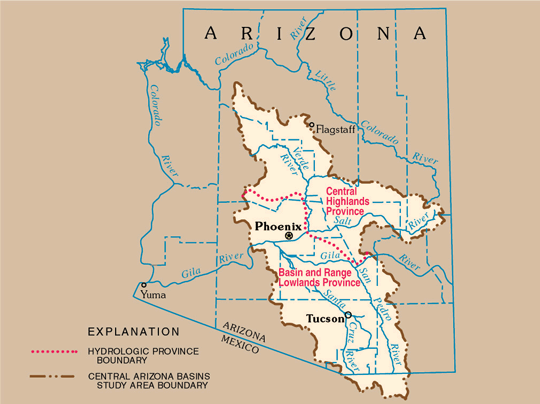SUMMARY OF MAJOR FINDINGS
 |
| The Central Arizona Basins (CAZB) Study Unit of the National Water-Quality Assessment (NAWQA) Program covers 34,700 square miles in the Central Highlands and Basin and Range Lowlands hydrologic provinces. Phoenix was America’s fastest growing city during the 1990s, and a population of about 3.8 million people is concentrated around the cities of Phoenix and Tucson. The climate is arid to semiarid, and dams on major perennial streams in the Central Highlands collect water for use in the Phoenix area. More than 50 percent of the water used in the Study Unit is ground water, which is often the sole source available. More than 70 percent of the water is used for agriculture, which accounts for 5 percent of the land use. |
Most of the perennial streams in the Central Arizona Basins (CAZB) Study Unit drain relatively undeveloped basins in the Central Highlands that are covered by forests and (or) rangeland. The water quality of these forest/rangeland streams is primarily determined by natural factors, such as chemical weathering of rocks and soils. About 24 percent of samples from forest/rangeland streams had concentrations of phosphorus that exceeded the U.S. Environmental Protection Agency’s (USEPA) desired goal for prevention of nuisance plant growth (eutrophication), whereas nitrate concentrations were typically less than the background levels for streams nationally. More than 75 percent of samples from the Salt River (above reservoirs) exceeded the USEPA drinking-water guideline for dissolved solids; however, rainfall and snowmelt runoff helped dilute these concentrations in reservoirs and in streamflow leaving the reservoirs.
 |
In the Basin and Range Lowlands, streams typically flow only when it rains (ephemeral streams). Consequently, a small fraction of the nutrients and dissolved solids applied to the land surface by human, animal, and natural sources is transported to streams. The remaining dissolved solids and nutrients are accumulating in basins and can degrade ground-water quality.
Urban streams with perennial flow are sustained by the discharge of treated wastewater (effluent-dependent). Agricultural/urban streams are a combination of wastewater and irrigation return flows. All samples from both the effluent-dependent urban and agricultural/urban streams exceeded the USEPA’s desired phosphorus goal for prevention of nuisance plant growth, and dissolved-oxygen concentrations were minimal for fish survival. Organochlorine compounds in streambed sediment and fish tissue from urban and agricultural/urban streams exceeded guidelines for protection of aquatic health and fish-eating wildlife.
- Effluent-dependent urban streams are valuable water resources; however, the water quality is poor.
- Organochlorine insecticides from past agricultural use persist in streams, streambed sediment, and fish tissue and are a concern because they exceed guidelines for protection of aquatic life and fish-eating wildlife.
- Insecticide concentrations in water from streams affected by agricultural and urban land uses were among the highest in the Nation.
Trends in stream water quality
Water quality of forest/rangeland streams generally is improving over time. From 1950-90, dissolved-solids concentrations decreased in outflow from reservoirs as a result of dilution from increased precipitation and physical and chemical processes in reservoirs. A decrease in nutrient concentrations in forest/rangeland streams in the early 1980s to 1999 could be attributed to decreased contributions from natural sources, better land-use management practices upstream, or increased nitrogen use by aquatic life.
| Major Influences on Streams and Rivers
|
Most of the ground water used in the CAZB Study Unit is pumped from basin-fill aquifers in the Basin and Range Lowlands. Water from major aquifers (basinwide) in the West Salt River Valley (WSRV), the Upper Santa Cruz Basin (USCB), and the Sierra Vista subbasin (SVS) generally meets existing USEPA standards and guidelines for drinking water with some exceptions. Nitrate and dissolved-solids concentrations in some samples from the WSRV and USCB exceeded USEPA drinking-water standards and guidelines. Shallow ground water from an agricultural area in the WSRV exceeded drinking-water standards and guidelines for nitrate and dissolved solids in more than 75 percent of samples. More than 90 percent of ground-water samples from the three basins exceeded the USEPA’s proposed drinking-water standard for radon. A small percentage of samples exceeded drinking-water standards for arsenic, fluoride, and molybdenum. Samples from urban and agricultural areas contained low concentrations of numerous chemicals (pesticides and volatile organic compounds) that can be linked to household, industrial, and agricultural uses.
- Most of the deep wells yield old ground water that generally has not been affected by land uses in the last 50 years.
- Use of fertilizers and treated wastewater on agricultural and urban lands and the evaporation of irrigation water have resulted in the accumulation of nitrate and dissolved solids in shallow ground water.
- Adoption of draft or proposed USEPA drinking-water regulations for arsenic, radon, and uranium—constituents that occur naturally in the study area—will require most water suppliers and municipalities to treat their water to remove these constituents or find alternative supplies.
- Pesticides detected in ground-water basins with substantial agricultural and (or) urban development did not exceed USEPA drinking-water standards and guidelines.
 |
Though trends in ground-water quality over time were not determined for the CAZB Study Unit, the data indicate possible future changes. As urban land use spreads with the growing population in the area, ground-water quality is likely to deteriorate, as indicated by detections of pesticides and volatile organic compounds in urban areas. Nitrate and dissolved solids accumulating in shallow ground water in the WSRV have the potential to degrade the quality of deeper drinking-water supplies.
| Major Influences on Ground Water
|
| Table of Contents || Previous Section || Next Section || Glossary U.S. Geological Survey Circular 1213 Suggested citation:
|

